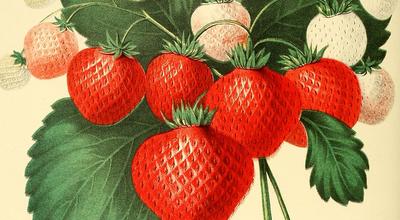Kiwiberries & cold temperatures
Resembling small kiwis without the fuzzy brown skin, kiwiberries are a minor horticultural crop that comprise many species in the Actinidia genus. The kiwiberry is one of the most recently domesticated fruit crops and is not produced abundantly in Minnesota where cold temperatures are a limiting factor to productivity.1,3 A. arguta and A. kolomikta, both of which are experimentally grown at the Minnesota Horticultural Research Center (HRC), are considered more cold hardy than most species in the genus. A previous study by Marosz et al. (2009) showed that at -29° F, most A. arguta varieties tested were completely frozen, but both A. kolomikta varieties had little to no damage.3 Coincidentally, temperatures at the HRC reached lows of -29° F during the polar vortex of January 2019.6 Therefore, that winter’s natural conditions set up an intriguing experiment to observe how lethal or near-lethal temperatures affect A. kolomikta and A. arguta differently.
Investigating molecular signs of cold damage
The objective of this project, funded by the UMN Undergraduate Research Opportunities Program, was to observe how extreme cold affects cellular structures in developing buds of A. kolomikta and A. arguta. Due to the superior cold hardiness of A. kolomikta, we suspected that A. kolomikta buds would have less cellular damage than A. arguta. At the HRC, we collected dormant buds of three A. arguta varieties before and after the polar vortex and dormant buds of two A. kolomikta varieties after the polar vortex. All buds were subjected to a 10-day protocol that chemically dried and preserved the plant tissue. The tissue was then embedded in paraffin wax, cut into thin slices with a microtome, dewaxed, and dyed with Toluidine blue to be imaged with a light microscope.
A closer look at kiwiberry shoot buds
The photo below shows a cross section of a kiwiberry bud that has been dyed to better visualize cellular structures and was taken with 40X magnification through a light microscope. Importantly, kiwiberry buds feature a crown, which separates the pith tissue from the developing bud (primordia) above. This micrograph of a dormant bud is shown in comparison to a photograph of a bud that has recently broken dormancy.
Molecular observations: cracks & sugars
While this is a small descriptive study, two key differences were observed between buds of A. kolomikta and A. arguta. First, fractures at the crown were common in A. arguta buds but absent in A. kolomikta buds. These large cracks are likely due to the formation of ice between cells. Such ice masses have been shown to develop in multiple plant species, especially conifers, and prevent ice from entering the bud but lead to damage of the pith tissue.2,4Second, darkly stained circular bodies were present throughout A. kolomikta buds and less common in A. arguta buds. These are likely saccharides (sugars). The accumulation of saccharides within developing buds has been well documented to contribute to increased freezing tolerance and cold hardiness.2,5
This study suggests that saccharides could play a role in the elevated cold hardiness of A. kolomikta, and that extracellular ice bodies likely form in A. arguta. No clear differences were observed between the A. arguta buds collected before and after the polar vortex. Additional microscopy work with a larger sample size could further elucidate how the tropical-tasting kiwiberry survives the sub-freezing temperatures of Minnesota.
Click here to watch a short video presentation of this research.
More info
Find more information on kiwiberry research at the University of Minnesota.
References cited
- Ferguson, A. R., & Seal, A. G. (2008). Kiwifruit. In J. F. Hancock (Ed.), Temperate Fruit Crop Breeding (pp. 235–264). Springer Science+Business Media, LLC.
- Kuprian, E., Munkler, C., Resnyak, A., Zimmermann, S., Tuong, T. D., Gierlinger, N., Müller, T., Livingston, D. P., & Neuner, G. (2017). Complex bud architecture and cell-specific chemical patterns enable supercooling of Picea abies bud primordia. Plant Cell and Environment, 40(12), 3101–3112. https://doi.org/10.1111/pce.13078
- Marosz, A. (2009). Comparison of winter hardiness and growth of Actinidia arguta and A. kolomikta cultivars grown in central Poland. Acta Agrobotanica, 62(2), 179–185.
- Neuner, G., Monitzer, K., Kaplenig, D., & Ingruber, J. (2019). Frost survival mechanism of vegetative buds in temperate trees: Deep supercooling and extraorgan freezing vs. Ice tolerance. Frontiers in Plant Science, 10(May), 1–13. https://doi.org/10.3389/fpls.2019.00537
- Tarkowski, Ł. P., & Van den Ende, W. (2015). Cold tolerance triggered by soluble sugars: A multifaceted countermeasure. Frontiers in Plant Science, 6(APR), 1–7. https://doi.org/10.3389/fpls.2015.00203
- Victoria, MN Monthly Weather. (2019). Accuweather. https://www.accuweather.com/en/us/victoria/55386/january-weather/2248112?year=2019
Acknowledgements
Thank you to:
- My mentors, Seth Wannemuehler and Dr. Jim Luby for their continual support and patience.
- Dr. Nelson Garcia for providing a histology protocol and generously teaching me the methods.
- Dr. Changbin Chen for kindly offering his expertise on interpreting the micrographs.
- Dr. Bob Guthrie for his guidance collecting kiwiberry buds and for harvesting A. arguta buds prior to the polar vortex.
This project was funded by the UMN Undergraduate Research Opportunities Program (UROP).






